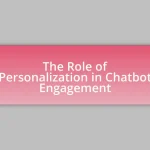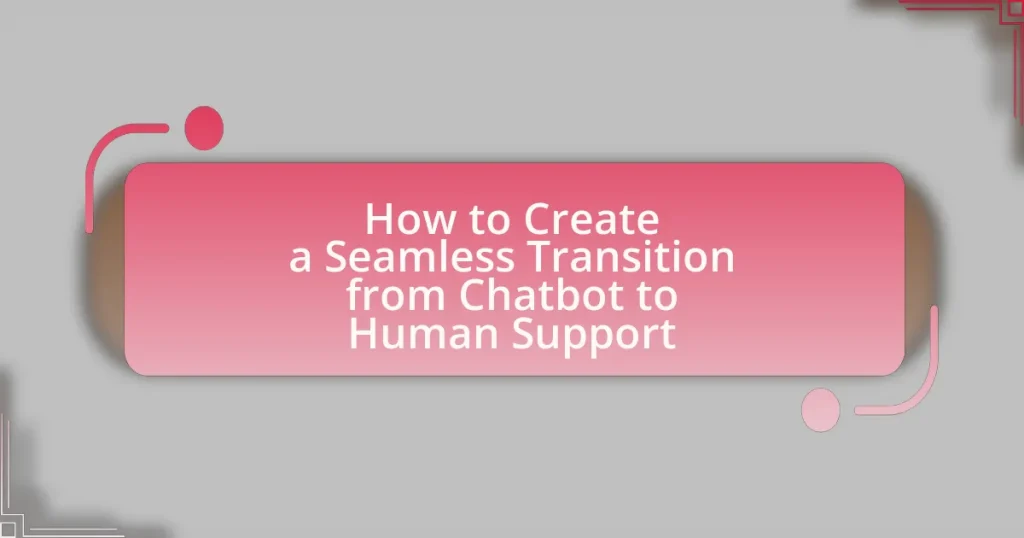The article focuses on creating a seamless transition from chatbot to human support, emphasizing the importance of maintaining service continuity and context during customer interactions. It outlines the transition process, which includes identification, escalation, handoff, and follow-up stages, and highlights the significance of effective communication and technology integration in enhancing customer satisfaction. Key challenges, best practices, and strategies for improving the transition experience are discussed, along with the role of training and customer feedback in refining the process. The article also addresses metrics for evaluating transition success and offers troubleshooting steps to ensure a smooth handoff.
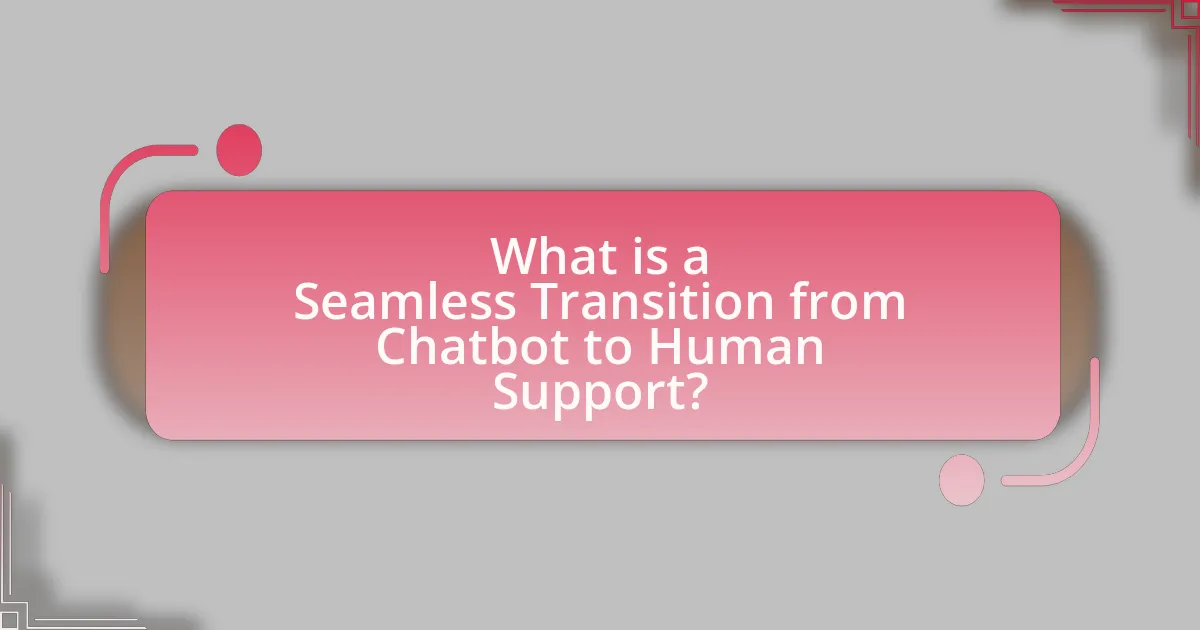
What is a Seamless Transition from Chatbot to Human Support?
A seamless transition from chatbot to human support is the process where a user is smoothly handed off from an automated chatbot to a human representative without disruption in service or loss of context. This transition is characterized by the chatbot effectively gathering relevant information and context during the interaction, which is then communicated to the human agent. Research indicates that 70% of customers prefer to interact with a human after a chatbot when their issue is complex, highlighting the importance of this transition in enhancing customer satisfaction.
How does the transition process work?
The transition process from chatbot to human support involves a systematic handoff where the chatbot identifies when it cannot resolve a user’s issue and escalates the conversation to a human agent. This process typically includes the chatbot gathering relevant context and user information, which is then passed to the human agent to ensure continuity. Research indicates that effective transitions reduce customer frustration and improve satisfaction rates, as evidenced by a study from Zendesk showing that 67% of customers prefer to speak with a human after an unsatisfactory chatbot interaction.
What are the key stages in the transition process?
The key stages in the transition process from chatbot to human support include identification, escalation, handoff, and follow-up. Identification involves recognizing when a chatbot cannot adequately address a user’s query. Escalation occurs when the issue is flagged for human intervention. Handoff is the actual transfer of the conversation from the chatbot to a human agent, ensuring that all relevant information is shared. Finally, follow-up entails checking in with the user to ensure their issue has been resolved satisfactorily. These stages are critical for maintaining user satisfaction and ensuring effective support.
How do chatbots identify when to escalate to human support?
Chatbots identify when to escalate to human support by analyzing user interactions and detecting specific triggers that indicate the need for human intervention. These triggers can include the complexity of the user’s query, repeated requests for clarification, or the use of keywords that signal frustration or dissatisfaction. For example, if a user asks multiple follow-up questions without receiving satisfactory answers, the chatbot may recognize this pattern and escalate the conversation to a human agent. Additionally, chatbots can utilize machine learning algorithms to improve their understanding of when to escalate based on historical data and user feedback, ensuring a more effective transition to human support when necessary.
Why is a seamless transition important?
A seamless transition is important because it ensures continuity in customer service, enhancing user experience and satisfaction. When customers interact with a chatbot and require human assistance, a smooth handoff minimizes frustration and maintains engagement. Research indicates that 70% of customers prefer a seamless experience when switching between automated and human support, as it reduces the need to repeat information and fosters trust in the service. This continuity not only improves customer retention but also increases the likelihood of positive reviews and referrals, which are crucial for business growth.
What impact does a smooth transition have on customer satisfaction?
A smooth transition from chatbot to human support significantly enhances customer satisfaction. This improvement occurs because customers experience reduced frustration and confusion when their inquiries are handled seamlessly, leading to a more positive interaction. Research indicates that 70% of customers prefer a smooth handoff between automated and human support, as it minimizes wait times and ensures their issues are addressed effectively. Furthermore, a study by Zendesk found that 87% of customers believe that a seamless transition contributes to their overall satisfaction with the service.
How does it affect operational efficiency?
The transition from chatbot to human support significantly enhances operational efficiency by reducing response times and improving customer satisfaction. When chatbots handle initial inquiries, they can quickly resolve simple issues, allowing human agents to focus on more complex problems. This division of labor leads to a more streamlined workflow, as evidenced by a study from Zendesk, which found that companies using chatbots reported a 30% increase in efficiency due to faster resolution rates. Consequently, the effective use of chatbots not only optimizes resource allocation but also elevates the overall customer experience, reinforcing the importance of integrating automated systems with human support.
What challenges are faced during the transition?
The challenges faced during the transition from chatbot to human support include miscommunication, user frustration, and inconsistent information delivery. Miscommunication occurs when the chatbot fails to accurately interpret user queries, leading to incorrect handoffs to human agents. User frustration arises when customers experience delays or lack of clarity during the transition process, which can negatively impact their overall satisfaction. Inconsistent information delivery happens when different human agents provide varying responses to the same issue, undermining the reliability of support. These challenges highlight the need for effective training and integration of systems to ensure a smooth transition.
What common pitfalls should be avoided?
Common pitfalls to avoid when creating a seamless transition from chatbot to human support include failing to provide clear escalation paths, neglecting to train human agents on chatbot interactions, and not monitoring the transition process. Clear escalation paths ensure users know when and how to reach human support, which is crucial for user satisfaction. Training human agents on previous chatbot interactions allows them to understand user context and respond effectively, enhancing the support experience. Monitoring the transition process helps identify issues in real-time, allowing for immediate adjustments to improve the overall flow.
How can technology limitations hinder the transition?
Technology limitations can hinder the transition from chatbot to human support by creating gaps in communication and functionality. For instance, if a chatbot lacks the ability to accurately understand complex queries or context, it may fail to escalate issues appropriately, leaving users frustrated. Research indicates that 70% of customers prefer human interaction for complex issues, highlighting the necessity for effective transition mechanisms. Additionally, inadequate integration between chatbot systems and human support platforms can lead to lost information and delays, further complicating the user experience.
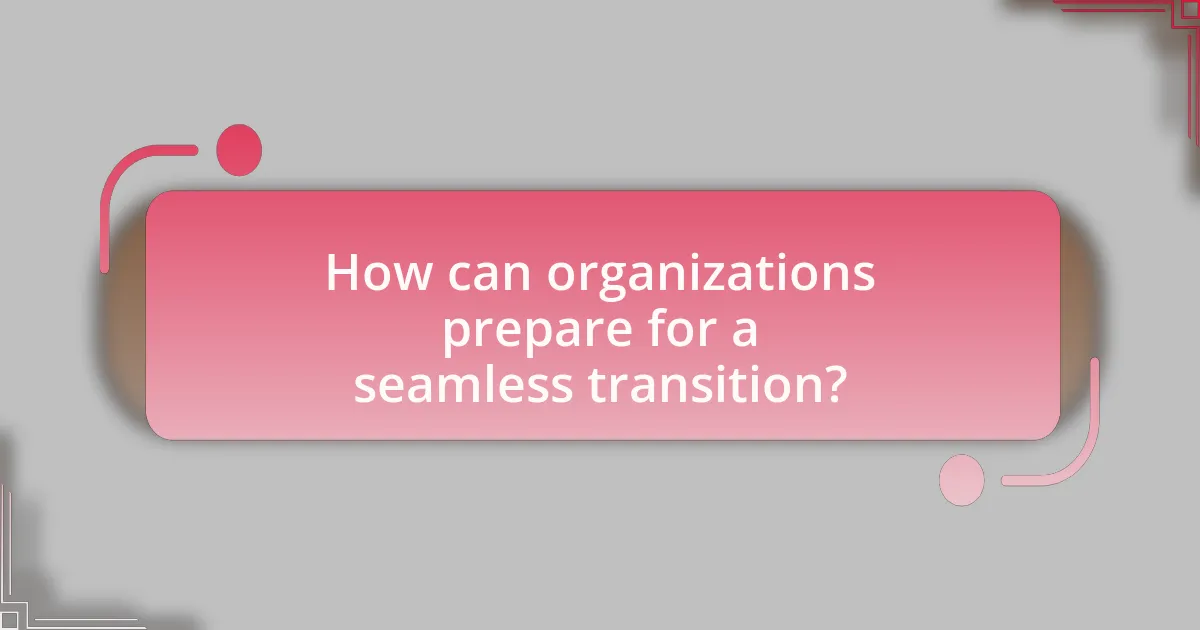
How can organizations prepare for a seamless transition?
Organizations can prepare for a seamless transition from chatbot to human support by implementing a structured handoff process. This involves training staff to recognize when a chatbot cannot resolve an issue and ensuring they can efficiently take over the conversation. Research indicates that 70% of customers prefer to interact with a human when their issue is complex, highlighting the importance of a smooth transition. Additionally, integrating customer relationship management (CRM) systems with chatbot platforms allows for the automatic transfer of conversation history, enabling human agents to quickly understand the context of the customer’s issue. This approach not only enhances customer satisfaction but also reduces resolution time, as evidenced by a study from Zendesk, which found that organizations with effective handoff processes experience a 30% increase in customer retention.
What strategies can be implemented for effective transition?
Effective transition strategies include implementing clear handoff protocols, utilizing shared knowledge bases, and ensuring real-time communication between chatbot and human agents. Clear handoff protocols define specific triggers for when a chatbot should escalate an issue to a human, enhancing user experience by minimizing confusion. Utilizing shared knowledge bases allows both chatbots and human agents to access the same information, ensuring consistency in responses and reducing the time needed for agents to get up to speed. Real-time communication tools, such as internal chat systems, facilitate immediate updates and context sharing, which is crucial for addressing customer inquiries efficiently. These strategies collectively improve the overall transition process, leading to higher customer satisfaction and operational efficiency.
How can training improve the transition process?
Training can improve the transition process by equipping both chatbots and human agents with the necessary skills and knowledge to handle customer interactions effectively. When chatbots are trained to recognize when a human agent is needed, they can seamlessly escalate issues, ensuring that customers receive timely and appropriate support. Additionally, training human agents on the specific capabilities and limitations of the chatbot allows them to better understand the context of customer inquiries, leading to more efficient resolutions. Research indicates that organizations that invest in comprehensive training programs experience a 20% increase in customer satisfaction during transitions from automated to human support, demonstrating the effectiveness of training in enhancing the overall transition process.
What role does customer feedback play in refining the transition?
Customer feedback is crucial in refining the transition from chatbot to human support as it provides direct insights into user experiences and expectations. By analyzing feedback, organizations can identify pain points in the transition process, such as delays or misunderstandings, and make necessary adjustments to improve efficiency and satisfaction. For instance, a study by Microsoft found that 70% of customers believe that a seamless transition between automated and human support is essential for a positive service experience. This data underscores the importance of actively incorporating customer feedback to enhance the overall effectiveness of the support transition.
How can technology facilitate a smooth transition?
Technology can facilitate a smooth transition from chatbot to human support by enabling real-time data sharing and context retention. This allows human agents to access the conversation history and user information instantly, ensuring they are informed about the customer’s issue without requiring the customer to repeat themselves. For instance, platforms like Zendesk and Intercom provide integrated systems that automatically log interactions and transfer relevant data to human agents, which enhances efficiency and customer satisfaction. Studies show that 70% of customers prefer seamless transitions between chatbots and human agents, highlighting the importance of technology in improving user experience during support interactions.
What tools are available to assist in the transition?
Tools available to assist in the transition from chatbot to human support include customer relationship management (CRM) systems, live chat software, and integration platforms. CRM systems, such as Salesforce, enable seamless tracking of customer interactions, ensuring that human agents have access to the chatbot’s conversation history. Live chat software, like Zendesk, allows for real-time communication and escalation from chatbot to human support. Integration platforms, such as Zapier, facilitate the connection between various tools, automating the transfer of information and improving the efficiency of the transition process. These tools collectively enhance the customer experience by providing continuity and context during the support handoff.
How can integration between chatbot and human systems be achieved?
Integration between chatbot and human systems can be achieved through the implementation of a hybrid support model that allows for seamless handoff between automated and human agents. This model utilizes advanced natural language processing to identify when a user’s query exceeds the chatbot’s capabilities, triggering an automatic escalation to a human representative. Research indicates that 70% of customer interactions can be handled by chatbots, but for complex issues, human intervention is necessary to ensure customer satisfaction. By employing real-time data sharing and maintaining context throughout the interaction, organizations can create a cohesive experience that enhances both efficiency and user experience.
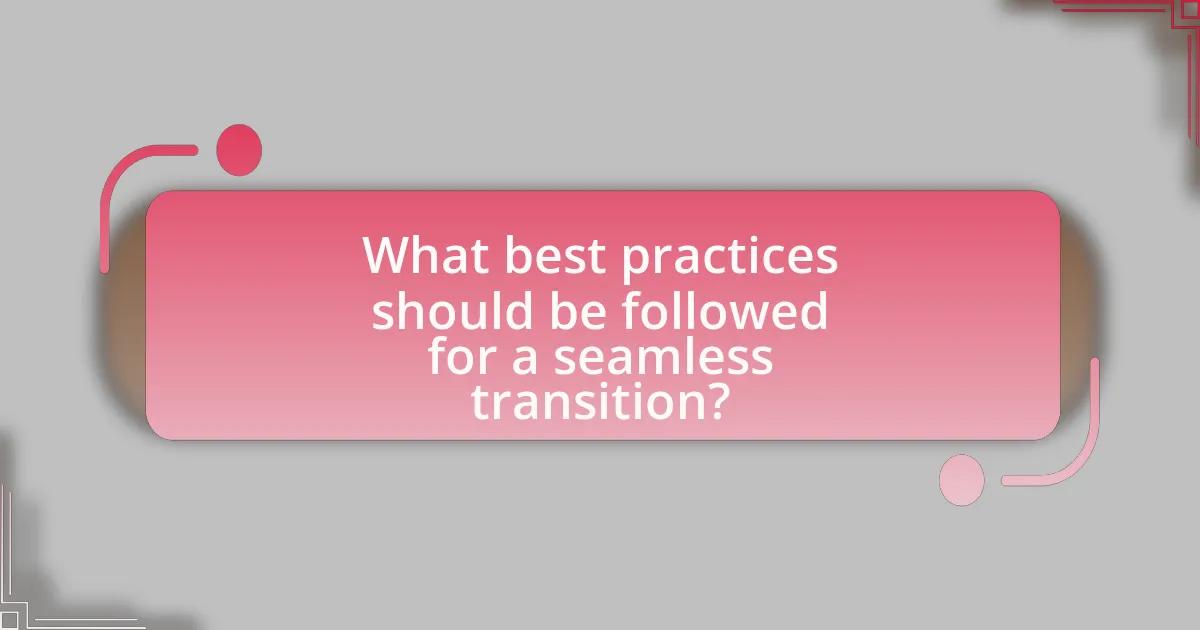
What best practices should be followed for a seamless transition?
To achieve a seamless transition from chatbot to human support, it is essential to ensure clear communication and context sharing between the two systems. This involves implementing a robust handoff protocol that includes transferring the conversation history and user context to the human agent. Research indicates that 70% of customers prefer to interact with a human agent after a chatbot, highlighting the importance of maintaining continuity in the conversation (Zendesk, 2021). Additionally, training human agents to understand chatbot interactions and providing them with tools to access previous chat logs can significantly enhance the user experience. By following these best practices, organizations can minimize frustration and improve customer satisfaction during the transition process.
What are the key elements of a successful transition plan?
A successful transition plan includes clear objectives, defined roles, effective communication strategies, and a structured timeline. Clear objectives ensure that all stakeholders understand the goals of the transition, while defined roles clarify responsibilities among team members. Effective communication strategies facilitate information sharing and address concerns, promoting transparency throughout the process. A structured timeline provides a roadmap for implementation, allowing for monitoring and adjustments as needed. These elements are essential for minimizing disruptions and ensuring a smooth shift from chatbot to human support.
How can clear communication enhance the transition experience?
Clear communication enhances the transition experience by ensuring that users understand the process and feel supported throughout. When users receive clear instructions and information during the transition from chatbot to human support, they experience reduced anxiety and confusion, leading to higher satisfaction rates. Research indicates that effective communication can improve user trust and engagement, which are critical during transitions. For instance, a study published in the Journal of Service Research found that clear communication significantly increases customer satisfaction and loyalty, demonstrating its importance in service transitions.
What metrics should be monitored to evaluate transition success?
To evaluate transition success from chatbot to human support, key metrics include customer satisfaction scores, resolution time, and escalation rates. Customer satisfaction scores, often measured through post-interaction surveys, indicate how well the transition meets user expectations. Resolution time tracks the duration taken to resolve issues after the transition, reflecting efficiency. Escalation rates measure the frequency of cases that require human intervention, providing insight into the chatbot’s effectiveness in handling inquiries. Monitoring these metrics allows organizations to assess the quality and effectiveness of the transition process.
What tips can improve the transition from chatbot to human support?
To improve the transition from chatbot to human support, ensure that the chatbot collects relevant information before the handoff. This allows the human agent to have context and reduces the need for customers to repeat themselves. Additionally, implement a clear escalation protocol that informs users when they are being transferred, which enhances transparency and user experience. Research indicates that 70% of customers prefer to interact with a human agent after a chatbot interaction, highlighting the importance of a smooth transition to maintain customer satisfaction.
How can organizations ensure consistency in customer experience?
Organizations can ensure consistency in customer experience by implementing standardized processes and training for all customer-facing employees. This approach guarantees that every interaction, whether through chatbots or human support, adheres to the same quality and service standards. For instance, a study by McKinsey & Company found that companies with well-defined customer experience strategies can achieve up to 20% higher customer satisfaction scores. Additionally, utilizing customer feedback mechanisms allows organizations to continuously refine their processes, ensuring that both automated and human interactions align with customer expectations.
What common troubleshooting steps can be taken during the transition?
Common troubleshooting steps during the transition from chatbot to human support include verifying the chatbot’s conversation history, ensuring the human agent has access to relevant customer data, and confirming that the handoff process is functioning correctly. Verifying the conversation history allows the human agent to understand the context of the customer’s issue, which is crucial for effective resolution. Ensuring access to customer data helps the agent provide personalized support, improving customer satisfaction. Confirming the handoff process is functioning correctly prevents disruptions and maintains a smooth experience for the customer.
